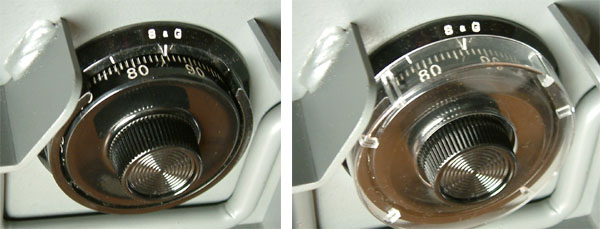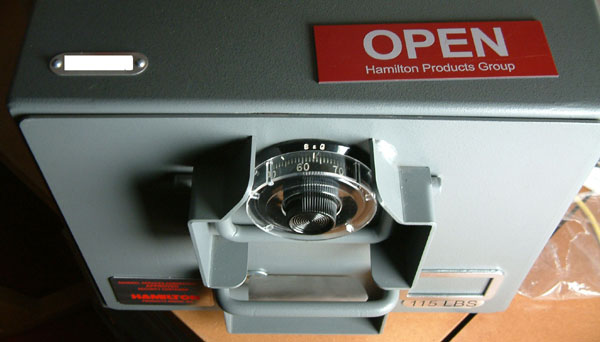And a very nice one too. Well, it is not actually a safe, it’s a secure
storage container. The US military uses them to store sensitive
documents and goods inside their facilities. The main objective of
this container is to make surreptitious entry as difficult as
possible. Therefore it is equipped with a sargent & greenleaf 8550
‘manipulation proof’ lock. The lock is protected from all four sides
by special ‘hardplate’ metal to prevent people drilling the lock.
A nice metal plate on the side of the drawer gives all the details of
what else this container is secure against. And there is nice sheet of paper with
schematics and part numbers on the inside of the locking mechanism.
The safe comes with a magnetic sticker that on one side says ‘OPEN’
and on the other side ‘CLOSED’. This is so the operator of the safe
can see in one view if a safe is closed or open (duh).
I tried googling around for this model for 15 minutes or so an could
not find it online.
There are some things that are not clear yet. For example, the
container comes with a transparent plastic cover to put over the dial.
Is this to protect the dial against dust? Or is there another purpose?

And on the front of the container the weight is noted in big letters.
Is this because it is used in an environment where balance is
important? Like an airplane or submarine? Again, we don’t know.
But I thank good old Santa for his nice present!
Feedback of readers is of course very welcome …


yea we have those in the army, used to store comsec and things, but the lock is not the same as the one you have, the locks we have on ours are a digital combination lock
Wow, Santa must think you’re really nice. (And, judging by the masked serial#, he must have his ways around.)
The weight of the container could also help determine the weight of the contents. Though I suppose your theory is more plausible.
They are also called “Fieldsafes” Because
they are used in the field with mobile camps.
And because they are in the field they need
dust covers. 😛
I must say 1 like that would look
nice in my collection next to my
manifoil docu safes. I think i have
to change my wishlist for next year.
The clear plastic is definately a dust cover.
I havent seen this type of cover used on a safe before, but i have seen it used on percision dials for metering, on field use equipment.
Its there just to prevent dirt, grime, greasy fingers, dust, etc. from falling into the dials number and scale impresions. Making them difficult to read clearly, or impossible to read in some instances.
Given the fact that this is a military safe, Im sure that the above mentioned conditions would be an almost certainty, not just an ocasional occurance.
The plastic cover is for preventing you to use your finger to stop the wheel and make fingerprints on the wheel and on the plate when you dial the combination, the half fingerprint on the wheel and the other half fingerprint on the plate will give out the combination….
And thats the only reason for the cover.
Hmm why dosent Santa bring me cool stuff like that.
You’re quite right Micke, the correct name is an anti-dusting (not dust) ring. It prevents the use of Aluminium or Talcum powder to determine any partial prints on the dial relative to a match on the dial ring.
If anyone with ill-intent were to tap the dial ring in a vertical axis, to make it bind slightly without losing the index reference, the user of the lock will automatically use their thumb as a ‘brake’to prevent overdialling a number. Try it with a friends safe (just for fun, of course)and see the results.
If you can match the prints to the opening index, on a 3 wheel lock, you have 9 tryout combinations, and with a 4 wheel, 16.
The weight is published on there because most of these safes are used in SCIFs secure compartmented information areas. Most of the floors in these buildings are raised so they can run cabling underneath the floor nice and neat. The floor has a weight limit so the weight of the safe must be published.
What you have is a Field Safe Container, the original lock was usually a Mosler 302/402 safe dial manipulation resistant lock assy. with multiple false ‘gates’ so as to not allow surreptitious or covert entry opening techniques to be used to open this safe. It has some 20 man hours-rated opening time requirement for use as a DOD approved field container. It requires at least a 20+ minimum time to destroy the thing in the field before it opens (usually these techniques destroy the contents by the use of heat and fire, but your in). This is one of the popular safes the military used until they realized the use of ‘quicker’ bypass methods and thus required the use of Electronic locks. Originally the X-07, now there up a few models, and they are nice I might say.
Yours is the first I’ve seen with a Sargent and Greenleaf lock on there. As for the dust cover, it’s a dust cover. The comment about using aluminum or talcum powder to discover a possible combination is interesting and rather cryptic (but you have to look at where these were used) and I think it has some relevance to it.
You got a good gift.
However cryptic the fingerprint comment may have been it’s entirely true for that lock (dust covers on newer X-07,8,and 9 locks are to prevent someone from inadvertently spinning the dial). This lock does not have false gates to prevent manipulation, instead the lever nose is held away from the wheel pack so it doesn’t make any noise or vibration when the gates do come around, therefore eliminating the possibility of manipulation.